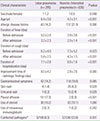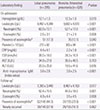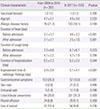Abstract
Purpose
This study was conducted to evaluate the difference of clinical characteristics of pneumonia in children caused by Mycoplasma pneumoniae, according to their chest radiographic patterns.
Methods
We analyzed medical records of 921 children who were admitted to Soonchunhyang University Buchon Hospital due to M. pneumoniae pneumonia from January 2008 to December 2011. Enrolled children were divided into 2 groups by radiological patterns: lobar/lobular pneumonia group (group 1) and broncho/interstitial pneumonia group (group 2).
Results
The number of patients in group 1 was 295 (32%) and in group 2, 626 (68%). Lobar/lobular pneumonia occurred in older children compared to broncho/interstitial pneumonia (mean age, 6.4 years vs. 4.2 years; P=0.00). Group 1 had significantly longer durations of fever and hospitalization than group 2. The frequency of pleural effusion was significantly higher in group 1. Erythrocyte sedimentation rate and C-reactive protein values were higher in group 1. Coinfections with respiratory viruses were more frequent in group 2. The history of allergic diseases were more common in group 2 (P=0.006). In 2011, lobar/lobular pneumonia was more frequent and the duration of fever was longer compared with 2008-2010.
Conclusion
In M. pneumoniae pneumonia, patients with lobar/lobular pneumonia were more older and had more severe clinical features and laboratory findings. Because there was an outbreak with severe clinical course in 2011, we wonder that the outbreak was related to the macrolide resistant M. pneumoniae. Careful attention about clinical course and consequences of patients with lobar/lobular pneumonia is required.
Figures and Tables
 | Fig. 4Computed tomography findings of bronchiolitis obliterans after Mycoplasma pneumoniae pneumonia. |
Table 1
Clinical characteristics of Mycoplasma pneumoniae pneumonia according to the radiologic patterns

Table 2
Laboratory findings of Mycoplasma pneumoniae pneumonia according to the radiologic patterns

Values are presented as mean±standard deviation or number (%).
CRP, C-reactive protein; ESR, erythrocyte sedimentation rate; AST, aspartate aminotransferase; ALT, alanine aminotransferase.
*Eosinophilia was defined as ≥5% of leukocytes. †Follow-up complete blood count was performed in 295 among 921 patients with M. pnuemoniae pnuemonia.
Table 4
Comparison of clinical characteristics of Mycoplasma pneumoniae pneumonia between 2011 and 2008-2010

References
1. Powell DA. Mycoplasmal infections. In : Kliegman RM, Stanton BF, St. Geme JW, Schor NF, Behrman RE, editors. Nelson textbook of pediatrics. 19th ed. Philadelphia: Elsevier/Saunders;2011. p. 1029–1032.
3. Kim JW, Seo HK, Yoo EG, Park SJ, Yoon SH, Jung HY, et al. Mycoplasma pneumoniae pneumonia in Korean children, from 1979 to 2006-a meta-analysis. Korean J Pediatr. 2009; 52:315–323.

4. Youn YS, Lee KY. Mycoplasma pneumoniae pneumonia in children. Korean J Pediatr. 2012; 55:42–47.
5. Yang EA, Gang MH, You SY, Kim JH, Lee JH. Clinical characteristics of children with lobar pneumonia caused by Mycoplasma pneumoniae. Pediatr Allergy Respir Dis. 2012; 22:256–264.

6. Ahn YH, Park SH. Clinical considerations about Mycoplasma pneumoniae pneumonia in the young, between 2003 and 2006. Pediatr Allergy Respir Dis. 2007; 17:249–259.
7. Youn YS, Lee KY, Hwang JY, Rhim JW, Kang JH, Lee JS, et al. Difference of clinical features in childhood Mycoplasma pneumoniae pneumonia. BMC Pediatr. 2010; 10:48.

8. Lee KY, Lee HS, Hong JH, Lee MH, Lee JS, Burgner D, et al. Role of prednisolone treatment in severe Mycoplasma pneumoniae pneumonia in children. Pediatr Pulmonol. 2006; 41:263–268.

9. Tagliabue C, Salvatore CM, Techasaensiri C, Mejias A, Torres JP, Katz K, et al. The impact of steroids given with macrolide therapy on experimental Mycoplasma pneumoniae respiratory infection. J Infect Dis. 2008; 198:1180–1188.

10. Hsieh SC, Kuo YT, Chern MS, Chen CY, Chan WP, Yu C. Mycoplasma pneumonia: clinical and radiographic features in 39 children. Pediatr Int. 2007; 49:363–367.

11. Lee KY. Pediatric respiratory infections by Mycoplasma pneumoniae. Expert Rev Anti Infect Ther. 2008; 6:509–521.
12. Lee K, Kim WJ, Kim DL, Kim JH, Chong MS. Frequency of Mycoplasma pneumoniae antibodies in children living on Jeju island. Korean J Clin Microbiol. 2012; 15:32–36.

13. Seo WH, Ahn SH, Kim SJ, Hwang SJ, Park HY, Lee JS, et al. An epidemiological study of Mycoplasmal penumoniae pneumonia in children from 1995 to 2004 in a tertiary hospital in Seoul. Pediatr Allergy Respir Dis. 2005; 15:53–60.
14. Byun SY, Bae YJ, Yoo JH, Jung JA. Comparison of clinical characteristics of Mycoplasma pneumoniae pneumonia according to the pleural effusion. Pediatr Allergy Respir Dis. 2006; 16:327–334.
15. Cho BH, Choi HS, Cho CH, Kim YH, Choi CW, Park MJ, et al. A case of Mycoplasma pneumonia presenting with RUL collapse. Tuberc Respir Dis. 2007; 63:511–514.

16. Niitu Y. M. pneumoniae respiratory diseases: clinical features--children. Yale J Biol Med. 1983; 56:493–503.
17. John SD, Ramanathan J, Swischuk LE. Spectrum of clinical and radiographic findings in pediatric mycoplasma pneumonia. Radiographics. 2001; 21:121–131.

18. Lee YH, Shin YL, Suh WS, Shin MY, Park JO. A clinical study of lobar/lobular pneumonia in children. Pediatr Allergy Respir Dis. 2009; 19:271–281.
19. Park JR, Lee HH. A clinical comparative study of Mycoplasma pneumoniae pneumonia in children under three years old. Pediatr Allergy Respir Dis. 2011; 21:91–98.

20. Kim CK, Chung CY, Kim JS, Hur G, Lee HE, Koh YY. The development of Bronchiolitis obliterans after Mycoplasma pneumoniae pneumonia: relationship with antibody titer and x-ray pattern. Pediatr Allergy Respir Dis. 1998; 8:64–71.
21. Putman CE, Curtis AM, Simeone JF, Jensen P. Mycoplasma pneumonia. Clinical and roentgenographic patterns. Am J Roentgenol Radium Ther Nucl Med. 1975; 124:417–422.
22. Narita M, Tanaka H, Abe S, Yamada S, Kubota M, Togashi T. Close association between pulmonary disease manifestation in Mycoplasma pneumoniae infection and enhanced local production of interleukin-18 in the lung, independent of gamma interferon. Clin Diagn Lab Immunol. 2000; 7:909–914.

23. Ozaki T, Nishimura N, Ahn J, Watanabe N, Muto T, Saito A, et al. Utility of a rapid diagnosis kit for Mycoplasma pneumoniae pneumonia in children, and the antimicrobial susceptibility of the isolates. J Infect Chemother. 2007; 13:204–207.

24. Kim S, Um TH, Cho CR. Evaluation of the chorus Mycoplasma pneumoniae IgM assay for the serological diagnosis of Mycoplasma pneumoniae infection. J Lab Med Qual Assur. 2012; 34:57–62.
25. Souliou E, Almasri M, Papa A, Theodoridou A, Diza E. Laboratory diagnosis of Mycoplasma pneumoniae respiratory tract infections in children. Eur J Clin Microbiol Infect Dis. 2007; 26:513–515.

26. McCormick DP, Wenzel RP, Senterfit LB, Beam WE Jr. Relationship of pre-existing antibody to subsequent infection by Mycoplasma pneumoniae in adults. Infect Immun. 1974; 9:53–59.

27. Daian CM, Wolff AH, Bielory L. The role of atypical organisms in asthma. Allergy Asthma Proc. 2000; 21:107–111.

28. Nah KM, Kang EK, Kang H, Park Y, Koh YY. Comparison of eosinophil markers between acute and recovery stages in children with Mycoplasma pneumoniae pneumonia. J Korean Pediatr Soc. 2002; 45:1227–1233.
29. Kim JH, Chae SA, Lee DK. Clinical findings of Mycoplasma pneumonia in children, from 1998 to 2003. Korean J Pediatr. 2005; 48:969–975.
30. Shames JM, George RB, Holliday WB, Rasch JR, Mogabgab WJ. Comparison of antibiotics in the treatment of mycoplasmal pneumonia. Arch Intern Med. 1970; 125:680–684.

31. Hong KB, Choi EH, Lee HJ, Lee SY, Cho EY, Choi JH, et al. Macrolide resistance of Mycoplasma pneumoniae, South Korea, 2000-2011. Emerg Infect Dis. 2013; 19:1281–1284.
32. Suzuki S, Yamazaki T, Narita M, Okazaki N, Suzuki I, Andoh T, et al. Clinical evaluation of macrolide-resistant Mycoplasma pneumoniae. Antimicrob Agents Chemother. 2006; 50:709–712.

33. Yun HJ, Kim YH, Hyun MC. The effect of immunoglobulin as adjuvant therapy in pediatric patients with antibiotic ineffective pneumonia. Pediatr Allergy Respir Dis. 2010; 20:17–22.
34. Noriega ER, Simberkoff MS, Gilroy FJ, Rahal JJ Jr. Life-threatening Mycoplasma pneumoniae pneumonia. JAMA. 1974; 229:1471–1472.

35. Chan ED, Welsh CH. Fulminant Mycoplasma pneumoniae pneumonia. West J Med. 1995; 162:133–142.




 PDF
PDF ePub
ePub Citation
Citation Print
Print







 XML Download
XML Download